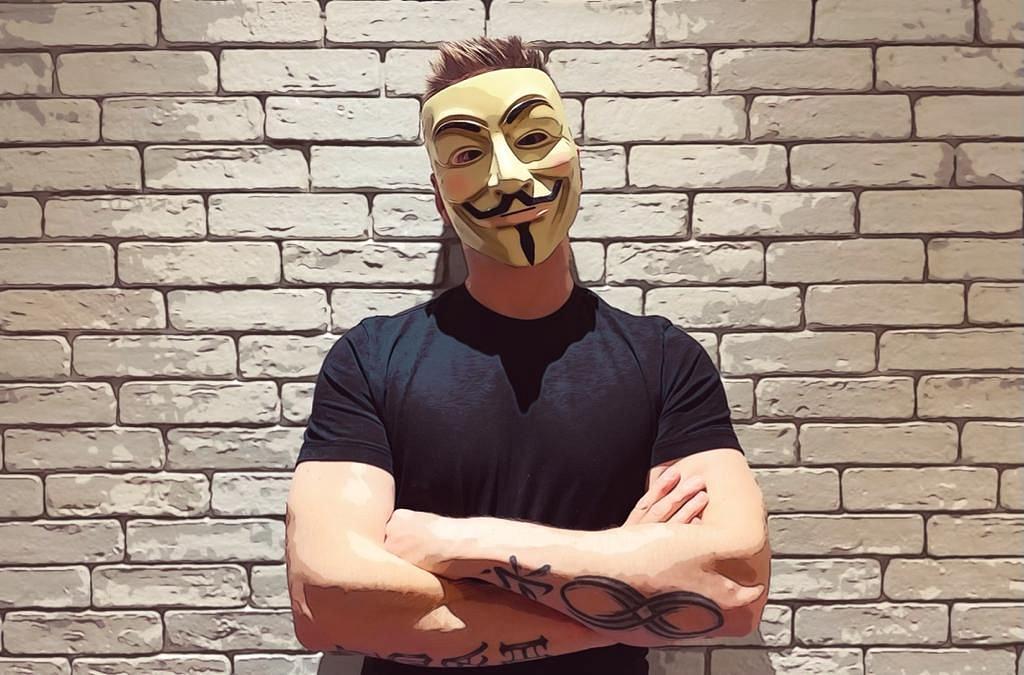Anonymous: Who are the shadowy cyber warriors who have declared war on Putin’s Russia?

Guest writer Grégoire Vigroux looks into the history of Anonymous as Russia’s invasion of Ukraine has led to a resurgence in hacktivism and cybermilitancy.
Anonymous has infiltrated Russia’s public television networks. On Twitter, the movement also launched a website, Behind Enemy Lines, that broadcasts hundreds of CCTV footage streams, taken from hacked Russian webcams and security cameras.
We often hear about Anonymous, but who exactly are they? How did their movement come about? And what have they achieved?
They walk among you
You rub shoulders with them at work. They repair your computers. You pass them on the street. They are students, civil servants, artists, journalists, business leaders and computer scientists.
They grew up with video games and a computer in their hands. Men and women of the shadows, they form a powerful community of anonymous people, a loose network ready to mobilize when required.
So, who is behind the mask? Some radicals, anarchists and revolutionaries. A handful of alter-globalists. But mostly idealists and progressives. They are the embodiment of cyberculture. Their territory is the internet.
A strange genesis
Since 2003, millions of anonymous internet users have visited the website 4chan, which features a forum and an image exchange platform. Its photos are often provocative and offbeat; the tone, libertarian; the humor, juvenile.
4Chan users can remain anonymous. Unlike most social networks, 4chan does not require users to register. Those who wish to withhold their identity therefore present themselves under the pseudonym of “Anonymous”, which is suggested to them by default.
The story could have ended there. But, on January 14, 2008, an event ostensibly unrelated to 4chan helps give birth to Anonymous as a movement.
The American branch of the Church of Scientology films a somewhat bizarre interview with Tom Cruise, during which the actor answers questions to the music of the film Mission: Impossible.
Cruise speaks fervently in support of Scientology, the sect to which he belongs. He says that Scientologists are endowed with amazing powers, meaning only they, for example, could intervene to save road accident victims.
The video, shot for internal recruitment purposes, is soon leaked and goes viral on the internet. Many internet users, especially on 4Chan, start mocking the sect.
The powerful Church of Scientology (which, let’s remember, generates $5 billion in turnover per year, claims 12 million members, and has 6,000 churches in 125 countries) reacts immediately.
It pulls out all the stops to get the video removed from the internet. An army of lawyers is put to work, threatening all online platforms that show it.
4chan users cry censorship. For them, Scientology's threats are a serious impediment to the free flow of information.
As one, thousands of 4Chan users hit back virtually. After plotting on the site's forum, they soon manage to block all Scientology websites, faxes and telephone lines, rendering it incommunicado.
In addition to this virtual response, internet users also demonstrate in person. They come together at the end of January, 2008, in their thousands, including in London, New York and Los Angeles, outside Scientology premises, to oppose the sect's censorship.
The virtual reprisals and the Anonymous protest against the sect are dubbed the “Chanology Project”, a portmanteau of 4Chan and the suffix of “Scientology”.
Scientology’s attempted censorship turns Anonymous into a movement in its own right – both in the eyes of its members, who suddenly become aware of their existence and their power, and in international public opinion, which is stunned to discover this mysterious shadow army.
The media immediately tries to unmask the group. But it soon realizes this is impossible, as the movement is atomized, and its tentacles, heterogeneous.
Anyone can claim to be Anonymous. There is no leader, no seat of power, no membership card, no training. It is enough simply to subscribe to the ideas of the movement and act.
Anonymous is a decentralized collective. The absence of hierarchy means members don’t give power to individuals who might be tempted to abuse it.
In 2008, the Anonymous community emerged and spread like wildfire – or like a computer virus.
Achievements
Since 2008, long before it targeted Putin's Russia, Anonymous waged many other high-profile battles, championing new causes, including:
- Promoting the democratic momentum of the Arab Spring, notably through the launch of Operation Tunisia, which helped block Tunisian government websites to resist the authorities’ internet censorship. Anonymous also posted online defense tips and kits that let the resistance use the internet to get images of oppression out of the country and inform media around the world.
- Denouncing Wall Street abuses. Many Anonymous members joined the peaceful protest movement “Occupy Wall Street” to denounce the abuses of financial capitalism. The movement began on September 17, 2011, when about 1,000 people demonstrated near the Stock Exchange district of New York.
- Fighting the American far right – one of whose leading figures is white supremacist politician Hal Turner, whose website was blocked in 2006 and whose radio show, which regularly features openly Nazi remarks, was sabotaged.
- In 2010, Julian Assange was arrested. Operation Payback was launched against the financial companies that froze Wikileaks’ assets, paralyzing the websites of PayPal, MasterCard and Visa.
- Blocking pedophile sites. In 2011, Anonymous blocked 40 child pornography sites, the largest being Lolita City. Anonymous also turned 1,589 usernames and email addresses over to the police.
- Combating terrorism. In 2015, after the Charlie Hebdo attacks, Anonymous attacked Daesh, blocking 3,000 Twitter accounts belonging to terrorists and their sympathizers.
During these operations, Anonymous is well organized. It acts at the speed of the internet, much faster than the decision-making of states, police, security agencies and other international institutions.
The choice of weapons
Anonymous' decision-making mode is do-ocracy, a form of organization where individuals gain power commensurate with their accomplishments and autonomous tasks.
Responsibilities are therefore entrusted only to individuals who take initiative.
The group’s main virtual weapons are:
- DOD (or Distributed Denial of Service), through which it can effectively block any website. Computer servers are not designed to cope with billions of connections per second.
- DDP (or Disclosure of Personal Data).
- Defacing, or hacking a site and replacing its home page.
To avoid getting caught, Anonymous uses programs that hide its online activity, such as TOR (The Onion Router), an easy-to-use tool originally developed by the US Navy.
Moreover, contrary to popular belief, you do not have to be a computer scientist to become a hacker. Thousands of amateur hackers can bring down the FBI website, provided they are numerous enough, coordinate properly and use the right tools.
Everything is symbolic
We mentioned earlier the emblematic Anonymous mask, the group’s standard, its rallying sign.
This mask is that of Guy Fawkes. On November 5, 1605, Fawkes tried to blow up the Palace of Westminster. He was arrested the same day, for having planted barrels of gunpowder intended to destroy the seat of the English government. Fawkes was sentenced to death and executed on 31 January 1606.
The motive for this failed attack was religious. King James I was to sit in Westminster that day: the sovereign was Anglican, while Fawkes was Catholic. Fawkes' “Gunpowder Plot” was intended to pave the way for a new monarchy, this time Catholic.
The following year, the English celebrated Guy Fawkes Day by building bonfires, on which they burned effigies of the revolutionary.
Years later, English children continue to celebrate the event, marching through the streets with a cardboard Fawkes mask.
In 1982, writer Alan Moore and cartoonist David Lloyd come up with the comic strip “V for Vendetta”, the story of a totalitarian England where a masked and lonely vigilante takes on the dictatorship.
Lloyd remembers the masks of his childhood and draws a face with a confident look and frozen smile.
Eighteen years later, the comic strip inspires cinema, and “V for Vendetta” is released on the big screen. The film, produced and directed by Andy and Lana Wachowski, who brought us The Matrix, is a smash hit.
At the center is the revolutionary character “V”. His mask is now available in stores around the world.
In 2008, the hacktivists of the “Chanology” project begin to use the mask of “V” as a rallying sign. During demonstrations, Guy Fawkes' face becomes the symbol of Anonymous.
Fourteen years on, the movement is opposing Putin's Russia. Anonymous members from all over the world are mobilizing, intent on countering Vladimir Putin's propaganda to his own people.
---
Grégoire Vigroux is a French Serial Entrepreneur and Business Angel, based in Romania since 2006. He co-founded and invested in 21 businesses across Eastern Europe - including Romania-Insider.com - and had 4 exits.
Grégoire believes entrepreneurs have an increasing role to play in shaping a meaningful world. He thinks success, in business, must come with responsibility. Profits with purpose. Growth with progress. Prosperity with philanthropy.
(Photo source: Grégoire Vigroux)













